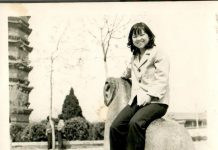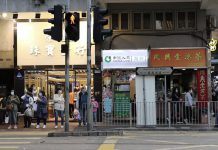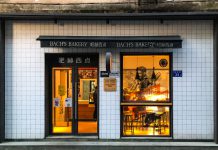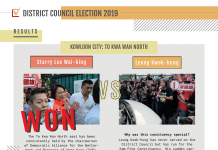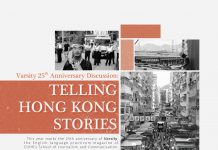Hong Kong lacks proper tree management and planning, say experts
By Yoyo Chan and Tommy Lee
A tree aged 20 to 30 years, its trunk measuring about 40 cm in diameter, sits dead in an inappropriately small planter. The trunk has become home to various fungi families, the canopy is gone due to over-pruning and topping. Sadly, this is a common sight that greets arborist Theresa So Fung-chun in the course of her work. Certified arborists, also known as tree surgeons, treat sick trees and take care of tree safety.
In this and in many other similar cases, improper tree management is probably the culprit. According to the former Civic Party legislator Tanya Chan Suk-chong, who is also a certified arborist, improper tree management stems from inadequacies in the government’s urban planning.
As an arborist certified by the International Society of Arboriculture, Chan says choosing the right location for trees is crucial in tree management. Trees need to have sufficient space for their roots to grow underground and their crowns to spread out above ground. The distance between trees should also be taken into consideration when planting them.
As an example of how not to manage trees, Chan cites the case of the heritage banyan trees in Tsim Sha Tsui’s Park Lane Shopper’s Boulevard that had to be cut down after they were killed by root rot. The growth of the trees’ roots had been restricted by the size of their planters. “Maybe they [the trees] were not suitable to grow there,” says Chan.
Inadequate planning is common in land-squeezed Hong Kong. Sometimes, trees are even transplanted from one location to another. Chan compares this to a person undergoing small-scale surgery. It hurts. She emphasises the importance of planning. “You need to have the right locations. Once you have that, the burden of caring for the trees is less.”
As Hong Kong does not have a centralised department overseeing tree management and the risk assessment of trees, Chan has drafted a tree ordinance proposal.
Under the proposed tree ordinance, there would be a committee that includes frontline professionals such as arborists, as well as experts on trees, landscaping and urban planning, along with citizen representatives. All members on the committee would have the chance to provide opinions on tree species, policies, and conservation.
At the time the ordinance was proposed, in 2011, the then Secretary for Development, Carrie Lam Cheng Yuet-ngor, pledged to seriously investigate the feasibility of legislation. It seems the investigation is still ongoing because we are no nearer to having an ordinance.
In the meantime, the government entrusts some tree management responsibilities to private companies. For Tanya Chan, outsourcing is not necessarily a problem, “but it doesn’t mean that the government is not responsible for tree management.” Chan cites a case in which outsourced contractors carried out inappropriate pruning of trees in Victoria Park, a case she says highlights the importance of monitoring.
Ken So Kwok-yin the chief executive of the Conservancy Association and a licensed arborist believes the government must play a leading role in supervising tree works.” If there isn’t any necessity for people to prune to a proper standard, then why would I spend so much time to bring it up to standard,” says So. He adds that there have been many cases of improper pruning that have damaged the health of trees, yet there is no punishment for offenders.
So also points to urban planning as a root cause for Hong Kong’s tree problems. He says that with the growing population in Hong Kong, any space available is used for development. Greening is the last thing to be considered. It is only after people’s basic needs are satisfied, that we start to call for greening, but no space has been reserved for planting, according to So, and it is hard to find new land on which to plant.
Although So can see a lot of room for improvement when it comes to tree management in Hong Kong, he is not totally negative about the government’s work in this regard. He is a non-official member of the Expert Panel on Tree Management, which acts as a channel for the industry and experts to communicate and coordinate with the government. So says there are now policies in place to make as much land available for greening as possible and he feels the government does respect the panel. “It[ the panel] is not the rubber stamp most people describe,” he emphasises.
Lawrence Chau, the head of the Tree Management Office under the Development Bureau, also defends the government’s record.
He reaffirms the importance attached to the conservation of trees, pointing to the establishment of the Tree Management Office as an example of the progress the government has made on the issue. Chau says the fatal accident, where a 19-year-old student was killed when a tree collapsed in Stanley in 2008, was a wake-up call. The Tree Management Office was set up after the incident.
As for Tanya Chan pointing out the dead trees in Park Lane Shopper’s Boulevard as an example of poor tree management in Hong Kong, Chau says the trees existed before the establishment of Hong Kong in 1842. He thinks it is unfair for people to use the unhealthy growth of these trees to criticise the government’s tree management. Chau says he knows what the problems are and explains things have improved in recent urban planning projects.
For example, earlier this year, the planter of a Chinese Banyan in Muk Lun Street Playground in Wong Tai Sin was widened to enlarge its growing area. It has also been registered as an Old and Valuable Tree. Similar work was carried out for the trees along Park Lane Shopper’s Boulevard.
What is more, current urban planning guidelines restrict any underground utility at the place of planting. This secures enough space for tree roots to grow. “We are well-aware of the limitations,” Chau says.
As for the proposed tree ordinance, Chau says he supports the idea but he is concerned about the limitations in Hong Kong. For instance, he says Hong Kong’s arboriculture is still developing – if the laws are set with many requirements and restrictions, individuals and organisations might not be able to cope with them.
Chau uses the analogy of an exam. “If there is an exam in which the pass mark is set as 90, but in a year there is only one person out of 100 who can graduate. Then what is the point of it?”
So while Chau agrees that implementing a tree ordinance could be a long-term goal, he believes tree management should be improved through a step-by-step approach for now.
At the moment, the government is only responsible for the trees on government-owned land. For trees on privately owned land, there is little the government can do.
There are rules in the title deeds stating that owners cannot cut down the trees at will but these are not included in older deeds. Besides, the government cannot enter privately owned land to assess the trees growing there as it would be regarded as an invasion of private property.
Teresa So Fung-chun is a certified arborist who treats sick trees for private organisations on request and carries out assessments on trees on government-owned land.
She recalls coming across a tree at a junction near Somerset Road in Kowloon Tong. The tree suffered from topping, in which all of the canopy and leaves were removed. It basically means death for a tree since leaves are important for food production. She believes the topping was carried out by a private horticulture company, and it was not an isolated case.
The Conservancy Association’s Ken So says many of those who work for horticulture companies in Hong Kong have not undergone proper training. “They haven’t learnt about what modern arboriculture is. They are only people who operate chainsaws,” he says.
So hopes that only people with proper qualifications will be allowed to operate on trees.
There are exams and certificates to ensure the standard of arborists. The exam that Tanya Chan Suk-chong took, issued by the US- based International Society of Arboriculture (ISA) is the most common one taken by arborists in Hong Kong.
But Sammy Au, the president of the China Arborist Association, who was the first person to become a registered arborist in Asia, is critical of the test. He has been an examiner for the ISA exam for over 10 years. Although it is the most common exam to assess the ability of arborists in Hong Kong, he finds it too basic. Those who merely took the exam would encounter difficulties if they practiced in reality.
Candidates only need to answer 144 multiple-choice questions correctly out of 200 in order to pass. The passing mark is 72 out of 100. “Some say attending lectures is not necessary, you could pass the [ISA] exam after only studying for three weeks,” Au says.
In response to this, Au is coming up with an exam specifically for Hong Kong. The first exam will be launched in March next year. It will consist of multiple-choice questions, short questions, assignments and interviews. The language to be used in the exam is Chinese. He hopes the exam can also be taken by people in China and Taiwan as well, as they might not be so familiar with the English language.
If Au’s plan succeeds, there should be more qualified frontline professionals working with Hong Kong’s trees, including in the private sector. But in the end, saving Hong Kong’s trees will require more than just greater numbers of experts and professionals. It requires a culture of conservation, as well as incentives, as Leon Lau Man-chung, a tutor teaching arboriculture courses at the REACH Professional Training Skills Development Centre, points out. “Is there anyone encouraging conservation? It is all about money.”
Lau criticises the government for requiring that people bear the responsibility for conserving trees without providing any subsidies. Instead of forcing private organisations to protect trees by law, Lau suggests starting a fund to help with conservation. He hopes that if the government can lessen the cost of conservation, people will be more motivated and willing to take good care of trees.
Edited by Sandy Ho













